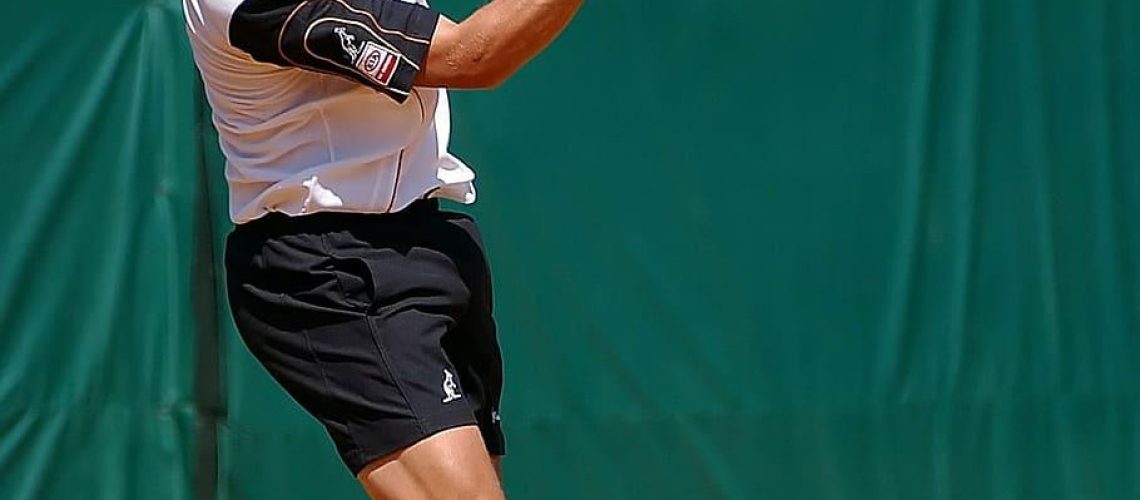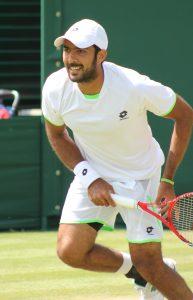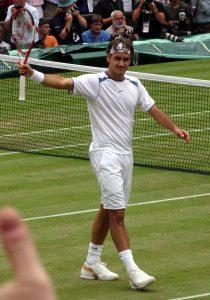We may earn money or products from the companies mentioned in this post.
Introduction

Tennis is a captivating sport filled with powerful shots, strategic plays, and intense rivalries One shot that often steals the spotlight is the tennis smash Known for its explosive nature and dramatic finishes, the smash can turn the tide of a match in an instant In this article, we will explore the definition of a tennis smash, discuss its importance and purpose in the game, and delve into common situations where players might employ this formidable shot
Definition of a Tennis Smash
The tennis smash, also referred to as an overhead or an overhead smash, is a shot executed when a player strikes the ball above their head with significant force towards their opponent’s court This shot typically occurs near the net when an incoming ball provides ample opportunity for an aggressive response
Importance and Purpose of the Smash in Tennis
The smash serves as a weapon in a player’s arsenal due to its ability to generate power and put immense pressure on opponents With its downward trajectory and velocity, it becomes challenging for opponents to return effectively or control the direction of play after facing a well-executed smash
Moreover, by employing smashes strategically throughout a match, players can disrupt their opponents’ rhythm and tactics A successful smash not only earns points but also intimidates adversaries, making them more cautious with their shots and potentially leading to unforced errors
Common Situations Where Players Might Use a Smash
There are several scenarios during gameplay where players may opt to use a tennis smash:
-
Lob Returns:
When opponents attempt lob shots – high arcing shots intended to clear the net player – smashes become valuable tools for countering these defensive maneuvers effectively -
Short Returns:
If an opponent delivers a weak or short return, players can seize the opportunity to move forward and execute a smash, capitalizing on their advantageous position near the net -
Serve and Volley:
When serving and subsequently charging towards the net for a volley, players may encounter high returns In such situations, smashes present themselves as ideal shots to maintain control of the point
The tennis smash is not only an impactful shot but also an exhilarating spectacle for spectators Its ability to shift momentum and create memorable moments adds to the excitement and drama of the game
Technique and Execution

When it comes to executing a powerful smash in tennis, having the proper grip is crucial There are two main grips that players commonly use – the Eastern grip and the Continental grip The Eastern grip involves placing your hand on the racket handle with your knuckles facing towards the sky, while the Continental grip positions your hand so that the base knuckle of your index finger is on or slightly touching bevel two of the racket handle
Choosing between these two grips depends on several factors, including personal preference and playing style The Eastern grip offers more control and topspin potential, making it suitable for players who want to place their smashes with precision On the other hand, the Continental grip provides more power and versatility, allowing players to hit flatter smashes or execute drop shots when needed
To maximize your smash effectiveness, it’s essential to adjust your grip based on different situations during a match For example, if you find yourself needing more power for an overhead smash, you can shift towards a slightly stronger Continental grip by sliding your hand down towards bevel three or four
Body Positioning and Footwork

A successful smash not only relies on a proper grip but also requires excellent body positioning and footwork Before even hitting the ball, it’s important to prepare yourself with a split-step This involves jumping slightly off both feet just as your opponent makes contact with the ball
Once you’ve completed your split-step preparation, you need to position yourself under the ball by either moving backward or sideways depending on its trajectory By taking quick steps in these directions while keeping your eyes fixed on the ball’s flight path, you can ensure that you’re in an optimal position for executing a powerful smash
Maintaining balance and stability during execution is also crucial As you move to position yourself under the ball, focus on keeping your body centered and balanced This will allow you to generate maximum power and control without compromising your stability
Swing Mechanics and Hitting Technique

The final key aspect of executing a successful smash lies in your swing mechanics and hitting technique To execute a powerful smash, it’s important to have a well-executed backswing, precise contact point, and follow-through
During the backswing, bring your racket back behind your shoulder while rotating your hips and shoulders to generate power As you make contact with the ball, aim for a high point above your head to maximize the angle of descent Finally, follow through with a fluid motion that extends both arms towards the target
In addition to proper technique, generating power in your smash also relies on weight transfer and rotation Shift your weight from back foot to front foot as you swing forward, transferring momentum into the shot Simultaneously, rotate your hips and shoulders in sync with the swing to add extra torque for increased power
An effective smash incorporates various components such as leverage, arc, and spin Leverage refers to using wrist snap at the moment of impact to add extra power and control The arc of the swing determines the trajectory of the shot – flatter arcs result in powerful smashes while higher arcs create more spin Lastly, applying spin can help manipulate the flight path of the ball or make it bounce differently upon landing, adding an element of unpredictability for opponents
Common Mistakes and Tips for Improvement

Mastering the tennis smash requires precision, timing, and technique However, many players fall victim to common mistakes that hinder their ability to execute a powerful and accurate shot By identifying these errors and implementing tips for improvement, you can enhance your smash and dominate on the court
Identifying common errors in executing a smash
-
Timing issues:
One of the most prevalent mistakes in smashing is mistiming the contact with the ball Hitting too early or too late can result in missed opportunities or weak shots To address this issue, focus on tracking the ball’s trajectory closely and practice your timing by hitting against a wall or using a partner -
Poor footwork:
Another common error that affects the success of a smash is poor footwork Many players fail to position themselves properly, leading to off-balance shots and reduced power To improve your footwork, work on agility drills that enhance your lateral movement and practice positioning yourself behind the ball before executing a smash -
Incorrect grip selection:
Gripping the racket incorrectly can significantly impact your control and power when smashing Using an inappropriate grip can cause mishits or reduce your ability to generate sufficient force Experiment with different grips such as the Eastern grip or Continental grip to find what works best for you
Tips for improving your tennis smash
-
Practice drills focused on timing, footwork, and shot accuracy:
Set aside dedicated practice sessions where you focus specifically on improving your smash technique Incorporate drills that simulate game situations while emphasizing proper timing, footwork, and shot placement -
Video analysis:
Utilize video analysis to identify areas of weakness in your smash By recording and reviewing your technique, you can pinpoint any flaws or inconsistencies that may be hindering your performance Take note of your footwork, racket position, and overall body alignment to make necessary adjustments -
Working with a coach or experienced player:
Seek guidance from a qualified coach or an experienced player who can provide valuable feedback on your smash technique They can offer personalized tips, correct any technical errors, and provide drills specifically tailored to improve your smash
By recognizing common mistakes and implementing these tips for improvement, you’ll be well on your way to smashing like a pro Practice diligently, stay open to feedback, and watch as your tennis smash becomes a formidable weapon in your arsenal
Strategies for Incorporating Smashes into Your Game

In the world of tennis, mastering the art of smashing can give you a significant advantage over your opponents A well-executed smash can not only earn you easy points but also demoralize your opponent In this article, we will explore some strategies to help you incorporate smashes into your game effectively
Recognizing opportunities to use smashes effectively
1 High lobs from your opponent as easy targets:
One of the best opportunities to unleash a powerful smash is when your opponent hits a high lob that gives you ample time to position yourself and strike the ball with precision Keep an eye out for those floating balls in the air and pounce on them with all your might!
2 Putting away short balls near the net:
Short balls that drop near the net are gifts waiting to be smashed! When your opponent hits a weak shot that barely crosses the net, seize this opportunity to step forward and deliver an explosive smash that leaves them scrambling to react
Developing tactics that set up smashing opportunities
To maximize your chances of executing successful smashes, it’s crucial to develop tactical approaches that create favorable situations for you Here are two effective techniques:
-
Using deep groundstrokes:
-
Utilizing powerful serves:
A deep groundstroke is a powerful shot hit from the baseline that pushes your opponent further back in their court This creates space for you to move closer to the net, anticipating shorter returns which can then be converted into devastating smashes
A well-placed serve with pace can force weak returns from your opponent By honing your serving skills, you can generate opportunities for smashes as your opponent struggles to handle the speed and accuracy of your serve
By recognizing effective situations and developing tactical strategies, you can incorporate smashes into your game with precision and finesse Practice these techniques consistently, and soon you’ll be dominating the court with thunderous smashes that leave your opponents in awe!
Useful Links

Tennis: the overhead smash | Life and style | The Observer
How do you execute a tennis overhead?
How to execute a perfect overhead smash
Tennis Smash: 5 Great Tips For You To Improve Your Smash
Improve your tennis game: Smash Attack
BBC SPORT | Tennis | Skills | The smash
Learning The Overhead Tennis Smash – Pro Tips
Tennis: The Overhead Smash
Dunk Smash – Prince of Tennis Wiki – Fandom
The overhead smash
Mario Tennis: Ultra Smash
Over Head Smash In Tennis
Smash Tennis Academy – Home
Tennis | Smash Drills
Smash Tennis Review (Super Nintendo)
19th Annual Desert Smash A Charity Celebrity Tennis Event
smash | Definition from the Tennis topic
Smash Tennis! on the App Store
Team Tennis to Smash Cancer 2022: Event Details
SMASH COURT TENNIS™ 3






